#faber publishing
Text



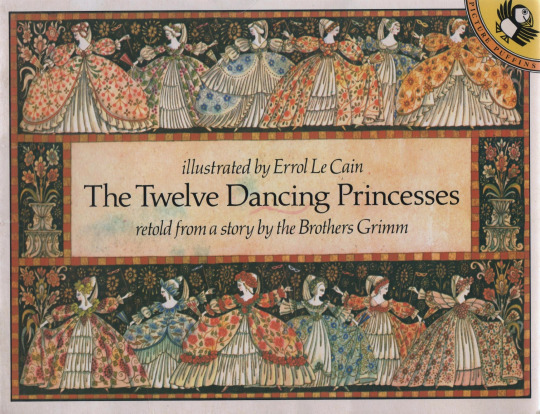
Errol Le Cain (British, 1941-1989) • Twelve Dancing Princesses (adapted from The Brothers Grimm) • Faber Publishing • 1978
#illustration#art#illustrator#artwork#errol le cain#brothers grimm#faber publishing#british artist#20th century illustration#fairytale illustration#children's book illustration#illustration blog#sassafras & moonshine blog#art & beauty
11 notes
·
View notes
Text
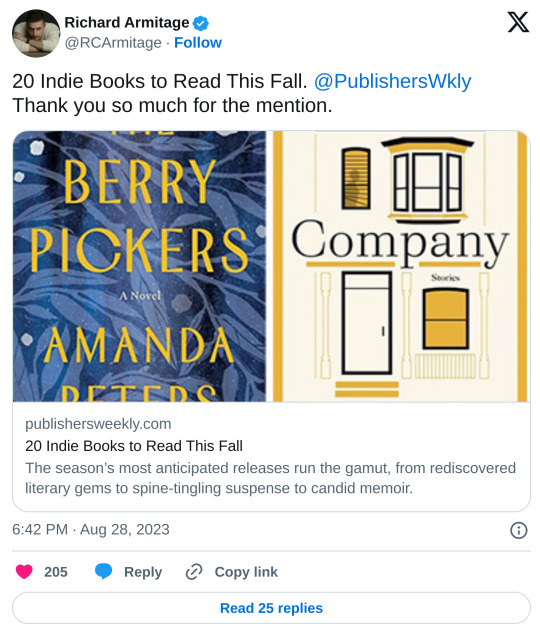
Publishers Weekly
#richard armitage#geneva#geneva book#book#faber#faber books#publishers weekly#post#tweet#twitter#twitter x#x#news
22 notes
·
View notes
Text
After the Armistice I waited to hear from him, not daring to ask myself, during those weeks of lively distraction, why no letter arrived. Several months elapsed before I was told about his death. I have never been able to accept that disappearance philosophically. A blank miserable sense of deprivation has dulled my mind whenever I have thought of him, and even now it has needed an effort of will to describe our friendship. Recognition of his poetry has steadily increased; but the chasm in my private existence remains. I am unable to believe that ‘whom the gods love die young’.
— Siegfried Sassoon, on Wilfred Owen
82 notes
·
View notes
Text

Sketch of Warren Publishing’s Vampirella (created by Forrest J Ackerman and Trina Robbins) from a photo of B-movie scream queen Brinke Stevens (who was married for a brief period to Rocketeer creator Dave Stevens). www.deadcatcomix.com
#doodles handlon#www.deadcatcomix.com#artists on tumblr#little doodles#comics#illustration#comic books#warren publishing#Forrest j Ackerman#Trina Robbins#brinke stevens#dave stevens#b movie#scream queens#vampirella#horror#sketching#moleskine#faber Castell markers#blackwing pencils
3 notes
·
View notes
Text
Vladimir: Did you ever read the Bible?
Estragon: The Bible... [He reflects.] I must have taken a look at it.
Vladimir: Do you remember the Gospels?
Estragon: I remember the maps of the Holy Land. Coloured they were. Very pretty. The Dead Sea was pale blue. The very look of it made me thirsty. There's where we'll go, I used to say, there's where we'll go for our honeymoon. We'll swim. We'll be happy.
Vladimir: You should have been a poet.
Estragon: I was. [Gesture towards his rags.] Isn't that obvious.
-
Samuel Beckett, Waiting for Godot (1955)
#samuel beckett#waiting for godot#modern theatre#theatre quotes#1955#modern drama#Godot had been written in 48 and 49 in French‚ and premiered in 53 in Paris‚ where Beckett was based#an english translation didn't appear until 54‚ and Beckett took the opportunity to make small edits and some significant substitutions#there were also edits for censorship (theatrical censorship being fairly draconian in 50s Britain; even a name like Fartov was considered#too much by the Lord Chamberlain) and once Faber published their version in 56 there were yet more changes and omissions#alas I picked up a copy on my way to work (for reasons‚ my job currently entails a lot of sitting around doing not very much) and grabbed#my old Faber edition (a corrected version wouldn't be available in english until the mid 60s) so I'm working from a bastardized text#actually Beckett would continue to tinker with Godot for the rest of his life‚ so the jury's out on which if any is the 'correct' text#nevertheless I'm having a great time. it's over a decade since i read this‚ as a lowly undergrad‚ and had my socks blown asunder#Beckett's prose has lost none of its magic; a carefully choreographed dance in words between two people who can't see their own moves#it's tempting to read all manner of subtext and innuendo into Beckett's minimalist dialogue‚ but the writer himself always strongly#resisted attempts at micro analysis; in fact he bored pretty quickly of the attention this play in particular seemed to earn‚ and would#repeatedly downplay any philosophical or political interpretations of the play. that's not to say those ideas don't exist or that those#readings lack merit; a play is almost by definition a political beast‚ a play of this kind in this era in this place and time particularly#so. but if Godot is any one thing more than others‚ it's a joyous examination of the art of conversation about nothing; more than any other#playwright (excepting perhaps Pinter)‚ you get the sense that every syllable was precisely and carefully chosen by Beckett‚ every word#carefully weighed and considered before inscription. perhaps then Godot is not a play at all; perhaps it is a poem#in loose free form‚ a sprawling poem of multiple voices in discordant harmony. or maybe it isn't. what do i know#I'm just a tumblr blog
77 notes
·
View notes
Text
Virago Press my beloved
#the only valid publishers.#if my writing takes off I want my prose to be published by virago and my poetry to be published by faber#this might be too niche but oh well
2 notes
·
View notes
Text
2024 Nonfiction Books
Most of these titles are not from academic publishers.
Teaching and Learning the Archaeology of the Contemporary Era edited by Gabriel Moshenska | 11 / 01 / 24 – Bloomsbury Academic
The tools and techniques of archaeology were designed for the study of past people and societies, but for more than a century a growing number of archaeologists have turned these same tools to the study of the…
View On WordPress
#2024#Birlinn Ltd#Bloomsbury#Bloomsbury Academic#Books#Endeavour#Faber & Faber#Footnote#Graywolf Press#HarperOne#HarperPerennial#Henry Holt and Co.#Ilex Press#Monoray#Nonfiction#Octopus Books#releases#Repeater#Watkins Publishing
0 notes
Text


Tales of Rain and Sunshine by Kayla Faber
🌈📚 A coffee shop sapphic short story.
Vera has just moved into a new neighbourhood and things aren't starting off the best way: her car broke down and the bus she's supposed to be taking to go to work is nowhere to be seen. On top of this, it's starting to rain.
She's cursing the universe, wondering what she did to deserve all of this, when a sunflower umbrella materialises over her head out of nowhere. A pretty girl is staring up at her, smiling.
This is the soft, cosy story of how Jade found Vera... and gave her more than shelter from the rain.
1 note
·
View note
Text
PODSUMOWANIE ROKU 2022 - Literatura
PODSUMOWANIE ROKU 2022 – Literatura
KSIĄŻKA ROKU 2022
Sylwia Chutnik „Tyłem do kierunku jazdy”
Wydawnictwo Znak
HONOROWY DYPLOM UZNANIA:
Wojciech Orliński “Kopernik” – Wyd. Agora
Annie Ernaux „Lata” – Wyd. Czarne
Alicja Urbanik-Kopeć „Matrymonium” – Wyd. Czarne
Anna Bikont “Cena” – Wyd. Czarne
Piotr Bernardyn “Hongkong” – Wyd. Czarne
Damon Galgut “Obietnica” – Wyd. Czarne
Sandor Marai “Porwanie Europy” – Wyd.…

View On WordPress
#Abdulrazak Gurnah#Agnieszka Krzemińska#Alicja Urbanik-Kopeć#Annie Ernaux#Art Rage#Barry Hatton#Damon Galgut#Emily St.John Mandel#Eric Vuillard#Faber & Faber#Grzegorz Piątek#Hwang Sok-Yong#Independent Publishing Network#J.K. Rowling#Krzysztof Umiński#Kumiko Makihara#Monika Milewska#Philip Watson#Piotr Bernardyn#PIW#Poradnia K.#Robert Galbraith#Sammy Stein#Sandor Marai#Sylwia Chutnik#Sławomir Leśniewski#Verna Kessler#William Souder#Wojciech Orliński#Wydawnictwo Agora
0 notes
Text
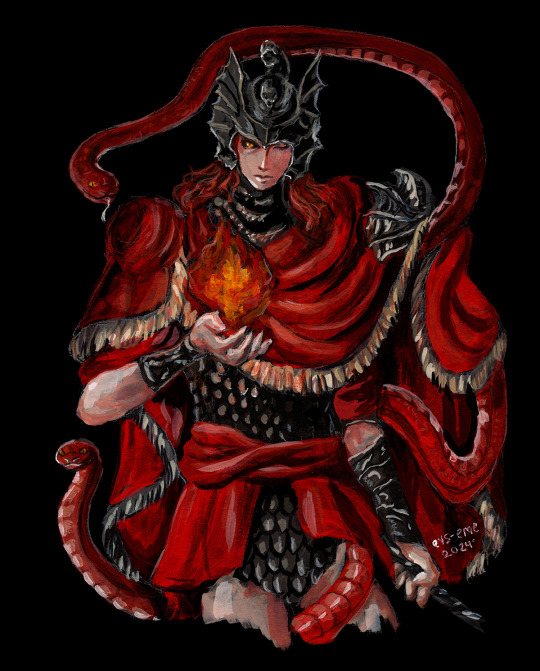
Messmer the Impaler - Elden Ring
A week ago the trailer for the long-awaited DLC for Elden Ring: Shadow of the Erdtree was published.
Just when I return from my vacation the post appears announcing the date and time of the trailer, the truth is that it is very cool at last we will know something more about Miquella and other things that Queen Marika will have done.
I made a fanart of Messmer the Impaler, I only know that I am going to suffer so much to defeat this boss, just like when I managed to defeat Malenia.
Eme
LINK: Deviantart Instagram Twitter or X
Tools: Painted with Holbein Gouche, Lyra Aqua Brush Duo markers, white ink,and lapices Faber-Castell Eco Super Soft.
#elden ring#my art#gouache#messmer the impaler#elden ring messmer#elden ring shadow of the erdtree#elden ring art#elden ring fanart#elden ring dlc
96 notes
·
View notes
Text

LEGO Almost Went Bankrupt. These Heroes Saved Our Bricks.
How a brain tumor inspired Bionicle, one of the most popular toys of a generation.
BY DAVID LUMB PUBLISHED: JUN 21, 2020

The Platinum Avohkii mask, a rare one- of-a-kind piece made of solid platinum purchased by Andre Hurley, who has The Bionicle Archives collection
Courtesy Andre Hurley/The Bionicle Archives
In 2003, LEGO seemed to be riding high after shrewd licensing deals brought Star Wars and Harry Potter sets to the masses. But unbeknownst to many—even those inside the company—sales were plummeting, and there were only guesses as to why.
Some blamed poor strategic choices in the 1990s—Legoland theme parks, forays into digital products—for LEGO’s hemorrhaging. All that misguided development time slashed profitability, and even Star Wars and Harry Potter sales shriveled between movie releases. It’s hard to conceive of now, but at the turn of the millennium, beloved LEGO might have been headed toward a pitiful end.
During this fallow period, one product line stood apart with startling, consistent success: Bionicle, a series of buildable action figures backed by rich worldbuilding and cross-platform promotion. Inspired by co-creator Christian Faber’s battle with a tumor at the base of his brain, the toy warriors of Bionicle wouldn’t just conquer their fictional enemies. They’d pioneer innovations that would transform LEGO and rescue the company from possible doom.

Courtesy Andre Hurley/The Bionicle Archives
Today, Christian Faber looks a bit like a Danish Paul McCartney. His youthful smile pairs well with his genial nature, which one might mistake for meekness until he starts talking about his creative projects. The 54-year-old embodies the unchecked enthusiasm you’d expect from a 28-year veteran of LEGO projects. If Faber’s long-time illness dimmed his appetite for play, you wouldn’t know it.
In 1986, Faber began working for Advance, a Copenhagen- based marketing firm that partners with LEGO. But shortly after his career began, Faber’s vision began to falter. A doctor found a benign tumor inside Faber’s pituitary gland that was impeding his sight, a condition called prolactinoma. Doctors said the tumor was maybe in the least accessible spot in the body for surgery, so they prescribed Faber daily medication to keep the tumor from growing. Among the drugs’ side effects, however, were severe nausea and dehydration, effectively sidelining Faber from social activities.

Courtesy Christian Faber
“It was the strangest mix of feelings,” Faber says. “I was happy at the job, but faced the physical and mental strain of the medicine and a long-term illness.”
Faber’s side effects attacked him hardest in the mornings, so he found most of his energy for work at night. Early in his career, Faber designed brochures for LEGO toy lines. Exposure to the different products, including the undersea-based Aquazone and the sophisticated Technic series, gave him experience with LEGO’s standards and practices—a moving target in the mid- 90s, when the rise of computers and video games pressured LEGO to move from their traditional years-long R&D cycle toward what Faber calls ‘craze products,’ toys tuned to current market tastes with a planned one-year shelf life.
The craze-products movement was rife with experimentation for LEGO, and it materialized soon after a medical breakthrough for Faber. After 10 years of daily medication, Faber’s physicians moved him on to a new treatment which, in Faber’s own words, gave him his life back. The new treatment was a regular injection scheduled just once every two weeks, allowing Faber to engage with the world relatively free from side effects. He could chase higher ambitions than brochures, and he had an idea for a new kind of LEGO toy: a sort of Bionicle precursor called Cybots.

Courtesy The LEGO Group
“I was sitting with LEGO Technic and thought I would love to build a character instead of a car,” Faber says. “I thought of this biological thing: The human body is built from small parts into a functional body just like a model. What if you got a box full of spare parts and built a living thing?”
With his assistant graphic designer Jan Kjær, Faber pitched Cybots, a line of humanoid action figures with attachable limbs and ball-and-socket joints. LEGO didn’t furbish Cybots, but they would implement Faber’s concepts in craze products like Throwbots in 1999 and RoboRiders in 2000. By 2001, LEGO was testing a line called Bone Heads of Voodoo Island—masked robots with heads that could shoot off their bodies like Rock ‘Em Sock ‘Em Robots. Most of Bionicle’s look had been seeded: masks, buildable bodies, articulate limbs.

Courtesy Andre Hurley/The Bionicle Archives
Bone Heads of Voodoo Island was a bust—focus groups demonstrated kids didn’t respond well to detachable heads—so that same year, LEGO pivoted to focus on Bionicle. The plan was to take a more holistic design approach with these new toys than with craze products, but LEGO extended that comprehensiveness to the worldbuilding around the toys, too, a new strategy for the company. Faber and LEGO design manager Martin Riber Andersen were joined by former BBC film and TV executive Bob Thompson and writer Alastair Swinnerton to refine the Voodoo Island concept and pitch a new story. Faber, fresh from working on Star Wars LEGO sets, imagined something massive.
“After being on Star Wars, I was thinking that the only thing to do from here is our own stuff, but it should be as big as Star Wars,” Faber says. “It should be a big, full universe.”
For the storyline, Faber drew on his experience with prolactinoma. To him, his every-other-week injections seemed like sending in a new wave of protectors to battle his tumor with every dose. Faber imagined this group of disease-fighters arriving on an unknown beach with no memory. The story of these warriors would be called Bionicle, a portmanteau of ‘biological chronicle.’
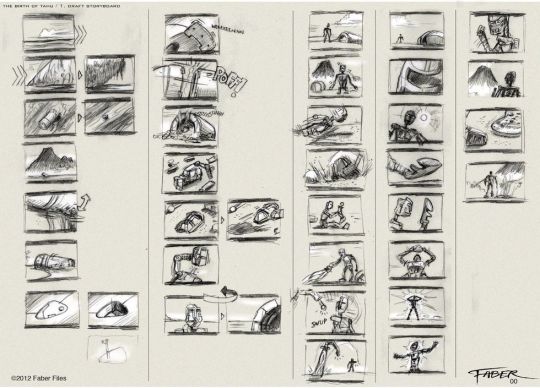
Courtesy The LEGO Group/Christian Faber
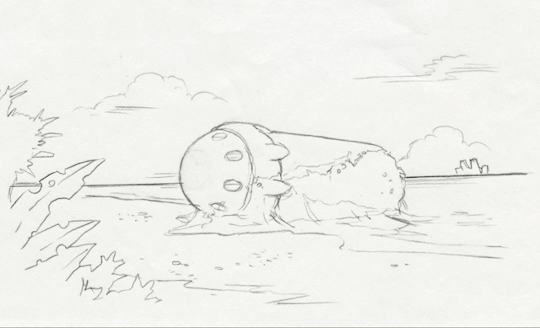
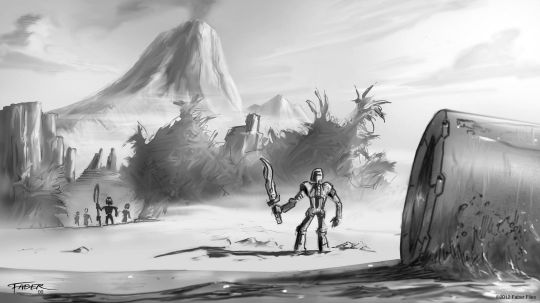
Courtesy The LEGO Group/Christian Faber

Courtesy The LEGO Group/Christian Faber
“We took an episodic story line but chose not to play it out in any single medium,” Thompson told Kidscreen in 2003. “We would take that story and scatter it like a paper trail through different types of media.”
Bionicle’s in-world story evolved through comics and chapter books, written in large part by Greg Farshtey of LEGO’s promotional periodical LEGO MANIA Magazine (also known as LEGO Club Magazine, but now called LEGO Life Magazine). Farshtey followed Bionicle’s story bible from the original team, but as he began accounting for character changes correlating with new toy sets, he added his own takes. By the end of Bionicle’s run in 2010, he had interwoven the story with three feature films and shepherded the comic series that, at its peak, reached almost 2 million readers per month, making it the most widely circulated monthly comic on the planet.

Courtesy Andre Hurley/The Bionicle Archives
By all accounts, Bionicle was the hit LEGO needed. In 2001, its first year on the market, the line brought in over $160 million in sales, it was declared “Most Innovative Toy of the Year” by the Toy Association.
"Flat sales and profit decline made LEGO believe the brick was passé and it needed to move to digital and virtual toys to remain relevant,” David Robertson, author of LEGO history book Brick by Brick, told Popular Mechanics. “But as Bionicle became a success, LEGO learned the difference between sufficient and necessary. It wasn't sufficient to just offer customers another box of bricks, but it was necessary. If a LEGO toy didn't have interlocking plastic pieces, consumers didn't want it. But to succeed and grow, it was necessary to embed a story in that box of pieces and tell that story through comics, books, video games, movies, and events at the LEGO Stores."






Courtesy The LEGO Group
In other words, Bionicle had all the ingredients of a fun LEGO toy, but Faber’s inspiration was key to making it a smash. “[My condition] had a direct effect on my career, and especially on the creation of Bionicle,” he says, ticking off the allegories. “A biological robot attacked by ‘illness,’ waiting for the right ‘medicine’ to arrive. Even the canisters the Toa warriors arrived in resembled the medicine capsules I had to eat every day.”
Bionicle hit its stride just as LEGO’s financials were bottoming out. While LEGO flirted with bankruptcy in 2003, Bionicle accounted for 25 percent of the company’s total revenue and 100 percent of its profits. As LEGO slashed its workforce, reduced the number of pieces it produced, and increased its range of licensing deals, Bionicle continued to diversify. Partnerships spawned. There were Bionicle-branded Nike shoes, McDonald’s Happy Meal toys, even Colgate toothbrushes. The cross-promotion paid off: By the end of Bionicle’s initial run in 2010, it sold over 190 million toys.
All the newness shook up LEGO’s tried-and-true project structure. Bionicle’s multifaceted development process blended design, marketing and engineering teams to hash out new sets, ingest market feedback, receive directives from LEGO executives, and issue their own directives to subsequent narrative and design teams. Under the new dynamic structure, development time for a new toy line at LEGO accelerated from three years to less than one. The rapidity created an exciting energy.
“We broke a lot of new ground experimenting and pushing boundaries,” Bionicle co-founder and design manager Martin Riber Andersen says. “One of the key ethos of the core team was this is a shared collaboration: We stand together. We all believed it was so in contrast to ‘the normal LEGO company’ that we might as well direct our energy to the team instead of our individual career objectives.”
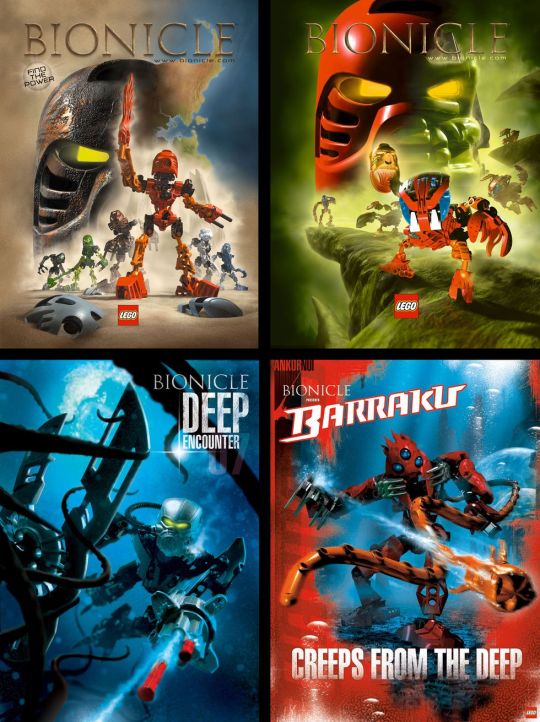
Courtesy The LEGO Group

Courtesy The LEGO Group/Christian Faber
From 2003 to 2005, Bionicle was the reported top-performing LEGO toy line, but after that, sales dipped below expectations. The decline continued to 2009, when LEGO handed down word it was time to end Bionicle. The creators wrapped up the narrative in 2010, but it was hard to let go. Farshtey wrote Bionicle stories on the now-defunct BIONICLEStory.com until 2011, fans dissected the line’s mythology on BZPower forums, and custom Bionicles continued to appear. In 2016, Faber wrote to series fans: “The stories we hear and the stories we tell shape who we are and what we do ... through almost 30 years [of my career in storytelling], no story has proved this stronger than Bionicle. The fans were, are, and will be the true heroes of this ... great adventure.”
These days, you still see Bionicle at toy conventions, and the r/bioniclelego subreddit is alive and well. In fact, the front page of Reddit was graced in November 2019 with an essential, timeless question: “What is the appropriate amount of time to wait before showing your new significant other your Bionicle collection?”
The toys’ invigorating combination of articulate LEGO figures and intricate, multimedia story resonated with the LEGO company as well as fans. The brickmakers use the business strategy they honed on Bionicle with lines like Ninjago today, to great success.
"It's hard to overstate how important the Bionicle line was for LEGO,” Brick by Brick author Robertson notes. “Without the sales and profits of Bionicle in 2003 and 2004, the company would not have survived. Bionicle taught LEGO that success depended on the ability to hook kids on characters and story, and LEGO was smart enough to spread those practices throughout the company."

Courtesy Andre Hurley/The Bionicle Archives
After Bionicle, Swinnerton moved on to write children’s books and TV scripts, Andersen took on a senior position
at a European consulting agency, and Thompson founded a media production and consultancy firm. Farshtey, meanwhile, still edits LEGO’s free fan magazine. All cite Bionicle as high points in their careers.
“We should all be proud of what we achieved individually,” Thompson says. “But in my view, more important is what we did collaboratively. After all, LEGO fans are still talking about what we did with Bionicle—after two decades.”
Faber moved on from his design job at Advance in 2014 after 28 years working on LEGO. His medical journey continues to inspire his creative work, including a post-apocalyptic world he’s designing filled with adventure, danger, and a pro- environmental bent. Looking back, Faber sees the impact his illness and treatment had on the stories and projects he’s touched. Almost 20 years after co-creating the action figures that sustained LEGO through one of the darkest times in its history, talking about Bionicle still makes him reflective.
“Biology is a balance more than a battle between good and bad,” he says. “Ever since Bionicle, balance has been my goal in the stories and pictures I create.”

Courtesy The LEGO Group/Christian Faber
article graphics faber bs01
82 notes
·
View notes
Text
The Reasonableness Theory of Good Omens

I’ve never done a Tumblr post before, but I’m going to have a go at it now, because the heaven/hell logics in the original Good Omens book (see also: the tv show The Good Place and also Terry Pratchett’s Discworld series generally) were foundational to the development of my theory of human behaviour – and I think it now explains A LOT about the Aziraphale/Crowley ending of Good Omens 2, and also what’s going wrong with us as a society.
So long story short – I’m a Cultural Studies academic at the University of Bristol, and I recently published a ‘smart thinking’ book called On Being Unreasonable: Breaking the Rules and Making Things Better (in bookshops now with Faber & Faber!). Here I explain how demands to “just be reasonable!” have been weaponised throughout history to halt social progress, from the suffragettes to Stonewall to the Civil Rights movement, up to the uproar over Black Lives Matter and Just Stop Oil protests today. Basically, what I think biblical-satire shows like Good Omens and The Good Place are satirising is exactly this: the inherent moral UNREASONABLENESS of the ‘reasonable person’, who wants things to be better but isn’t willing to break any rules to achieve it – even if those rules are bafflingly unfair and nonsensical (like the Job plotpoint, where Aziraphale began to realise this for the very first time).
When I say the ‘reasonable person’, I’m talking about the ‘moderate’ whom Dr Martin Luther King famously described in his Letter from Birmingham Jail as being almost worse than the ‘evil’ side of the out-and-out racist. This is the so-called ‘good’ side, who talk the language of progress whilst getting in the way of any attempt to realise it because they are “more devoted to ‘order’ than to justice”. In On Being Unreasonable I trace an overarching tendency to value the APPEARANCE of reasonableness (calm voices, shiny smiles, dapper suits) over the messy impoliteness of standing up and fighting back. In other words, rather than Heaven being the good guys and Hell the bad guys, Good Omens exposes how BOTH sides end up doing bad things because they’re unwilling to rebel against authority, break unjust rules/laws, and actually do what is RIGHT. We saw this especially clearly, I think, in the hell fire/holy water scene: one side might be ugly and the other side beautiful, but both sides are shown to be monstrous. “Just shut your stupid mouth and DIE already!” is still evil even though it’s said through a smile rather than a scowl.
This is where Crowley comes in. Crowley sees Heaven for who they really are. And this is why he resents being called ‘nice’ – because the qualities of niceness have historically been used as cover for tremendous evil – like how God’s ineffable command to kill Job’s children was morally horrifying, but how the Angels’ smiling promise to replace them with new children made a terrible thing seem like an act of divine grace. In many ways I’m saying nothing new here at all, I know – ‘omg the good side are actually the baddies! gasp!’ is hardly a novel literary interpretation. But it’s a bit more complicated than just that. What I’m talking about here is the specific sociopolitical mechanism by which reasonable appearances have been confused with actual moral goodness – and how this impulse to see ‘nice’ and think ‘good’ has historically been weaponised against us. It’s this that Good Omens really exposes. As I say in On Being Unreasonable, we can see this everywhere. “Think about the honeyed gentility of the American South, where smiling courtesy provided cover for simmering racial violence. Think about the buttoned-up laced-down aggression of the white imperial invader, sitting on their verandas in the Indian sunshine sipping tea. Think about the polished performances of the Nazis, with all their approving 1930s newspaper articles about impeccable manners and rarified tastes in art and dress”. In fact, there’s even an adjective for this: ‘Minnesota Nice’, which is often used as a backhanded compliment to refer to people who avoid confrontation in favour of a veneer of false politeness, and for whom calling out homophobia/racism/misogyny/etc is unforgivably rude. Nice, in this sense, can never be good, because it is being used to advance evil.
In Good Omens, what we saw is how deeply Aziraphale longs to break free from this logic, but how he can’t yet quite manage to free himself from that sense of reasonable idealism – the belief that surely the ‘good’ side of this broken system can be reformed from within. Meanwhile, Crowley is clearly being depicted as a fallen Angel in the true sense – someone who realises that the system itself is rotten to the core, and is willing to ask the hard questions and break rules in pursuit of truly moral actions, even if it costs him everything. Crowley has bitterly learned never again to make the mistake of confusing order with justice; this is a lesson that Aziraphale still needs once and for all to learn.
In the conclusion to On Being Unreasonable I set out a kind of matrix of behaviour to explain all this, where the Unreasonably-Unreasonable people are – like Hell! – “the deliberate contrarians and hate-speech purveyors and greed-is-good libertarian individualists, who think they can say and do whatever they want without consequences no matter the harm to anyone else”. Meanwhile, like Heaven, a lot of self-professedly progressive people seem to have become “so determined not to be like them that we’ve become something just as bad” – namely, Unreasonably-Reasonable people, “obsessed with tone-policing and respectability politics and endless toothless debate, happy to act the devil’s advocate and platform hate-speech and injustice so long as everyone appears to be doing it politely”. What I think we’ll see unfolding in Good Omens 3 is the revelation that what the world ACTUALLY, desperately needs is more people like Crowley, the Reasonably-Unreasonable people on whom social progress has always depended: “those who understand that civic dissent and smashing down racist statues and no-platforming bigots might sometimes be the only way to make the world a better place”.
So if God (and Neil Gaiman) really does have an ineffable plan then maybe it was this. Crowley needed to fall then, and Aziraphale needs to try to reform Heaven and fail spectacularly now, in order for us all collectively to rid ourselves of that morally-unreasonable urge to seem reasonable in the face of great injustice forever.
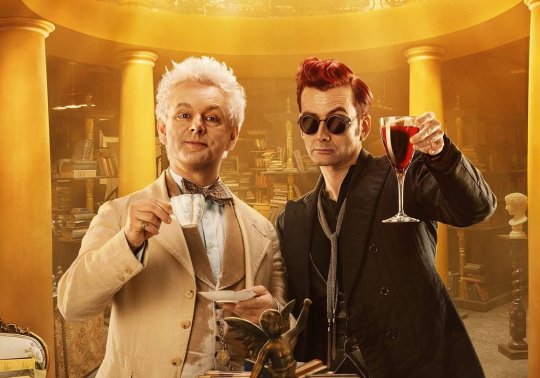
#good omens#good omens meta#aziraphale#aziracrow#crowley#good omens 2#neil gaiman#michael sheen#david tennant#ineffable husbands#good omens spoilers
100 notes
·
View notes
Text

20 Indie Books to Read This Fall by Publishers Weekly.
11 notes
·
View notes
Text
…imagine what you are writing about. See it and live it. Do not think it up laboriously, as if you were working out mental arithmetic. Just look at it, touch it, smell it, listen to it, turn yourself into it. When you do this, the words look after themselves, like magic.
— Ted Hughes, Poetry in the Making: An Anthology (Faber & Faber; First Edition, January 1, 1968) Originally published January 1, 1967. (via The Vale of Soul Making)
38 notes
·
View notes
Note
I went to a lot of comic cons in college. My impression was that most of the creators were… creatives. People that spend long hours in front of a drawing board or a typewriter, building worlds out of the aether that is their brain(s). That’s illustration to me. Physically manifesting the metaphysical, moment by moment. Picking the best moments for each beat of the story.
I -flat out- went to school to be a comic book artist. I just cannot fathom feeding my wife and my boys by manifesting the images in my head into a monthly income. But hey, that’s me. Your work is a continuous source of inspiration and joy for me.
My eldest son loves the power rangers. He he drew the green ranger in pencil on a canvas. He then painted the drawing with acrylic. He had a full-on meltdown when the painting didn’t look as good as he wanted it to look.
I sat with him and explained the process of creating comic book artwork. From blueline to publication. I spoke with him about the value of perseverance, and the value of using mixed media. He waited a day and then outlined his painting with Sharpie. He BEAMED with pride when he showed me the final product. Made me so, so happy.
Rodin was a hack. Dude had no deadlines, and no narrative outline.
Keep being awesome. You are an inspiration to me, to my boys, and to generations to come.
I am so glad you are encouraging your son to make art and enjoy it, and it is great that you find so much to appreciate in comic art and have so much respect for those who make it. We all truly appreciate it.
A few thoughts, if I may.
If you want your son to understand and appreciate mixed media, you might want to move him away from using markers like Sharpies.
If you are concerned about the longevity of the original art, I regret to inform you alcohol based markers such as Sharpies and Copics are not lightfast. That is to say, they fade on exposure to UV light. They do not use pigmented inks, they use dyes.
The fading may not happen today, it may not happen tomorrow, but it will happen sooner than you would like. Many well-known cartoonists who used Sharpies on their original comic pages, or did commissions sketches using them, have seen the art fade markedly (pun intended) over time.
Here's what that looks like.

This Klaus Janson commission has just about gone home to Jesus.
Try to switch to pigment based markers, such as those from Faber Castell, or go wild and learn to use a crow quill.
Also, while I truly appreciate your kind compliments, it's not necessary to do that at another artist's expense.
Rodin was the complete opposite of the definition of "hack".
A hack is a term originally used for one who works on tight deadlines to publisher specifications, and produces poor quality work.
That's not Rodin.
Rodin was a spectacular talent who earned his place in the canon. He came from humble beginnings and spent the first two decades of his career sculpting decorative architectural elements. He obtained his place as a fine artist after many years of struggle.
And even then, a fine artist often works to deadline, as there are salons and exhibit specs that must be met, as well as the requirements of patrons and clients, to say nothing of the grueling formal training aspiring artists were subjected to in the ateliers.
His work often contains strong narrative elements as well, as evidenced by his design for The Gates of Hell.
In fact, for most of the history of modern art, narrative elements were considered anti-art. As someone who prefers 19th century genre art, this attitude is bummerific.
The term "hack" comes from the 17th century term "Grub Street Hacks".
Back in the day writers did not get royalties. Bookstores usually published books and paid writers a flat fee and never another penny, which resulted in a lot of very broke writers, or writers who came from wealthy families who could afford to scorn the sordid topic of coin.
Grub Street was located in London where a lot of book publishers were housed next to brothels and flophouses. It's now known as Milton Street. This area was the location of the lowliest of the low publishing joints.
The great Samuel Johnson was once a Grub Street Hack.
I've just read the most wonderful book about Samuel Johnson which has many amazing details about the development of publishing. The Club: Johnson, Boswell and The Friends Who Shaped an Age. My highest recommendation, though some will be very upset by attitudes and behaviors toward the women in these men's lives.
Johnson, despite many years of poverty, was able to escape after his work eventually earned him a royal pension. When well-thought of creative people couldn't make royalties, they were supported by wealthy patrons and the royal pension system.
While I don't have a formal education, I spent many years doing research for auction catalogues and ghost writing articles about art history, which is why I am annoyingly pedantic about it all to this day.
63 notes
·
View notes
Text

Daily excerpt from today's writing, chapter 84 of Underline the Black:
‘We’ve had a leak of information, and the local paper, and The Swan River Gazette have both published articles.’
‘Tell me.’
Faber sighed. ‘Rumours that you’re in a relationship with an omega, after refusing to leave your sick alpha partner, who died from cancer. They’ve made a point of saying that you refusing to leave and let him be with an omega is the reason his cancer accelerated so quickly and he was resistant to treatment.’
‘He wasn’t-’
Gary forced himself to stop, and then looked over at Efnisien, who’d gone a bit pale. Gary realised he’d spiked his pheromones without thinking. He placed a soothing hand on Efnisien’s shin where it was up on the couch, and then stood and walked into his office. He closed the door behind him.
‘I’ve sent you the articles,’ Faber said. ‘I’m relatively certain – based on the lack of information - that the rumour is from one of our contracted staff who don’t understand the situation, and that the leak isn’t from any of our full-timers, or any of the alphas or omegas on site. But beyond that, the newspapers won’t reveal their sources, as always.’
‘Damn it,’ Gary said. ‘I know for a fact they have better things to report on.’
#underline the black#underline the rainbow#dr gary konowalous#efnisien ap wledig#faber castle#omegaverse#mm romance#queer romance#angst with a happy ending#romantic drama#hurt/comfort#i've known this chapter was coming for a while#and we've slammed into this part of the plot!#wheeeeeee
22 notes
·
View notes